Science Safety
Chapter 5
Workplace Hazardous Materials Information System (WHMIS)
Labelling
Material Safety Data Sheets
Education and Training
WHMIS is a provincial legislative response to provincial employees' and employers' rights to know about the safety and health hazards of the materials they use in the workplace. This system and supporting documentation also provide sufficient information to ensure that people work safely with these materials.
Teachers, students, custodians, and other staff may be exposed to hazardous materials. Such exposure can cause or contribute to serious health effects, such as effects on the nervous systems, kidney or lung damage, sterility, cancer, burns, and rashes. In addition, some hazardous materials may pose immediate physical or chemical risks, such as causing a fire or an explosion. WHMIS informs and protects school staff about such risks.
Three major components to WHMIS include
- Labels applied to containers of hazardous materials (called "controlled products" in the legislation). The labels alert the user to the dangers of the product and to the essential precautions for its safe use.
- Material Safety Data Sheets (MSDS) must be prepared by the product supplier and supplied to the user. These sheets provide detailed information about product composition, reactivity, health effects, protective equipment and procedures, and emergency procedures. Over sixty pieces of information, in nine separate sections, must be completed. Blanks are not permitted and a symbolic "N/A" must be clarified as "not applicable" (e.g., N/App) or "not available" (e.g., N/Av). Each MSDS must be dated and must not be more than three years old. See sample sheets for more detailed information.
- Education and Training related to hazards and associated safe work procedures is mandatory for those either working with or working in the proximity of the controlled product. The school is responsible to develop safe work procedures using knowledge of the job, the information from the labels, and the MSDS. It is expected that all teachers be trained sufficiently to use the information and training to protect themselves and their students. (Teachers must inform their principals of safe work procedures and insist that they are followed.)
Note: The provisions of the WHMIS legislation with respect to laboratory chemicals (under 10 kg) are slightly different from those dealing with industrial chemicals.
WHMIS legislation took effect throughout Canada on October 31, 1988. All controlled products sold after this date must meet the legislated labelling, MSDS, and worker education requirements or the product can not be used, handled, stored, or prepared for disposal. Combustible, corrosive, toxic, or highly reactive substances should be kept to a minimum and labelled as to their contents.
The WHMIS definition of controlled product does not apply to radioactive materials, pesticides, explosives, consumer products, or materials covered under Food and Drug legislation (with respect to labels and MSDS, as a condition of sale). An equivalent amount of information is provided to workers to ensure the safe use of these products. Wood and tobacco (and products made of these substances), manufactured articles, and hazardous wastes are excluded from all aspects of WHMIS. Other provincial health and safety laws and regulations cover the hazards of these materials.
WHMIS Classifications and Symbols

Class A — Compressed Gas

Class B — Flammable and Combustible Material

Class C — Oxidizing Material

Class D — Poisonous and Infectious Material
1. Materials Causing Immediate and Serious Toxic Effects

Class D — Poisonous and Infectious Material
2. Materials Causing Other Toxic Effects

Class D — Poisonous and Infectious Material
3. Biohazardous Infectious Material


Proper labelling is one of the most important aspects of an effective and safe laboratory operation. Purchased stock chemicals kept in the storeroom and materials that are generated in the laboratory for and by student experiment require proper labelling. WHMIS requires increased information on labels of potentially hazardous materials.
Labels warn handlers of potential hazards and therefore they must present the required information clearly and legibly. The formal "supplier label" contains seven elements of information inside a distinctively marked border product identifier, supplier identifier, WHMIS hazard symbol(s), risk statement(s), precautionary statement(s), first aid information, and a reference to the MSDS. Laboratory chemicals from a recognized supply house may carry less information on the label (i.e., WHMIS symbols, distinctively marked border, and the supplier identifier). For example:
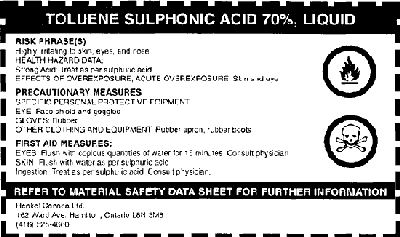
All chemical containers, including the original container, must be labelled in such a way as to identify the contents clearly. Inside the laboratory, small transfer containers and reaction vessels containing mixtures, solutions or reaction products must have a clear identifier, usually the chemical name. Outside the laboratory, transfer containers must carry a workplace label. This form of label has three components--the chemical identifier, instructions for safe use (combination of risk phrase and precautionary statement), and a reference to the MSDS.
Acceptable Format for the Workplace Label
Additional Labelling Requirements
Other legislation in Canada requires precautionary labelling on containers of hazardous materials (e.g., explosives, pesticides, or radioactive substances). Specific guidelines for the transportation of dangerous goods (TDG) have been developed to handle emergency response in the event of a spill or other accident under section D12 of the Dangerous Goods Handling and Transportation Act. These are also outlined in Prudent Practices for Handling Hazardous Chemicals in Laboratories published by National Academy Press in 1981. Transporting vehicles require diamond-shaped hazard placards.
WHMIS is a complementary information system to the TDG regulations (consumer packaging is also regulated). In some jurisdictions, liability suits have been based on the inadequacy of a label on materials involved in an accident. Adequate labelling practices should help protect the teacher and school division/district from liability where labelling is the primary issue. TDG regulations do not cover the hazards of extended exposure in the workplace or the long-term effects of exposure.
U.S. System of Labelling
In 1977, the National Fire Protection Association (N.F.P.A.) in the United States developed a hazard coding system and an accompanying label. Although the system was not originally developed for use by laboratories, it has since become widely accepted in both industrial and educational laboratories throughout North America. It is a simple, easily understood coding system which identifies hazards associated with health, flammability, and reactivity of any given material as well as indicating special hazards associated with a substance. While WHMIS labels are the primary requirement in Canada, some chemicals come from the United States with the N.F.P.A. hazard diagram (see sample and a chart). They should be understood by Canadian users.
The hazard label or diagram is divided into four coloured quadrants:
- The left hand quadrant (blue) indicates the relative health hazard.
- The top (red) quadrant indicates the flammability hazard.
- The (yellow) right hand quadrant indicates the relative reactivity of the substance.
- The bottom quadrant (white) is used to indicate any special characteristics (e.g., oxidizing substances are identified with the letters OXY in the bottom segment, radiation hazards are indicated with the radiation symbol and water reactive substances have the letter W with a line drawn through the middle of it [ W ]).
- The seriousness of any given hazard is indicated by the number located in the appropriate segment. Five digits from zero to four are used. A zero represents little or no hazard in that particular category, while substances with a four indicate extreme hazard (see illustration).
Chemical containers sold in Canada in recent years usually have N.F.P.A. labelling, but in some cases the colours in each quadrant are not present.
It is important to note that the health hazard designations refer only to acute effects of exposure to the chemical. The long term, chronic effects are not taken into account.
A complete listing is available from the N.F.P.A. Guide on Hazardous Materials (see Appendix J).
Note: The N.F.P.A. system is provided as information only - it is not acceptable by itself (WHMIS is the Canadian standard).
Student Handout: N.F.P.A. Hazchem Code
| Flammability | ||
| Health | 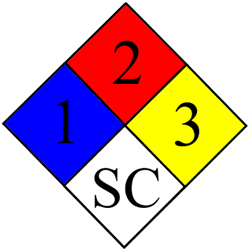 |
Reactivity |
| Special |
Note: The colour-coding is often not consistent among manufacturers. Some omit colour entirely.
Category One - Health (Blue)
- 4 - Can cause death or major injury despite medical treatment.
- 3 - Can cause serious injury despite medical treatment.
- 2 - Can cause injury. Requires prompt treatment.
- 1 - Can cause irritation if not treated.
- 0 - No hazard.
Category Two Fire (Red)
- 4 - Very flammable gases or very volatile flammable liquids.
- 3 - Can be ignited at all normal temperatures.
- 2 - Ignites if moderately heated.
- 1 - Ignites after considerable preheating.
- 0 - Will not burn.
Special Category Three Reactivity (Stability) (Yellow)
- 4 - Readily detonates or explodes.
- 3 - Can detonate or explode but requires strong initiating force or heating under confinement.
- 2 - Normally unstable but will not detonate.
- 1 - Normally stable. Unstable at high temperature and pressure. Reacts with water.
- 0 - Normally stable. Not reactive with water.
Key to Hazard (Special) Comments
- C - may be carcinogenic upon chronic exposure
- Cor corrosive
- Exp - risk of explosion
- Oxy oxidizing agent
- SC suspected carcinogen
- T toxic
W water reactive- Pol polymerizes under normal conditions
Material Safety Data Sheets (MSDS) must be supplied with hazardous chemicals and may be requested for other chemicals. Teachers and students should be familiar with the type of information contained on a MSDS and be able to interpret the sheets from a variety of chemical suppliers. Although the numbering of sections and the order of appearance may differ from supplier to supplier, the following must be on each MSDS:
- Product Identification and Use
Manufacturer's name
Supplier's name - Hazardous Ingredients
- Physical Data
Colour, form, solubility
Melting and boiling points
Vapour pressure, specific gravity - Fire and Explosion Data
Flammability
Flashpoint
Fire fighting procedures - Reactivity Data
Stability and Hazards - Toxicological Properties
Threshold Limit Values (TLV)
Effects of exposure
Carcinogenicity - Preventative Measures
Protective clothing
Protective equipment
Spill and handling procedures - First Aid Measures
- Preparation Date of MSDS
Teaching About MSDS
It is important that students have practical experience
interpreting samples of MSDSs. A sample activity and resource
sheets follow, but teachers are encouraged to provide students
with MSDS experience in a variety of situations. (Information
related to MSDSs can be found on the Internet by performing
a search using MSDS as a keyword. Some helpful sites include:
http://www.ccmr.cornell.edu/helpful_data/msds.html,
http://www.chem.uky.edu/resources/msds.html,
and http://research.nwfsc.noaa.gov/msds.html.)
MSDS Student Activity
Objective: To be able to read and interpret an MSDS.
Materials:
A. Transparencies of a blank MSDS, and one for a chemical to be
used in the near future (optional).
B. Per student or group of 4-5 students, one set of:
- Blank MSDS (supplied),
- MSDS for sodium hydroxide (supplied),
- MSDS for sodium hydroxide from present supplier (if available).
Procedure:
A. Have students examine a blank MSDS, noting the details of
each of the nine sections.
B. Examine the MSDS for sodium hydroxide with the class. Discuss
the need for each section and note the comments. If you have a
copy of an actual MSDS from a supplier, compare the two in terms
of the information supplied.
C. When students have completed examination of the MSDS, the
teacher may ask questions, such as:
- Are the eyes, face, mouth, and skin considered to be external or internal parts of the body?
- Does ingestion occur when something is taken into or splashed on the outside of the body?
- If a student is performing a lab and splashes some sodium hydroxide solution in his or her eye, would that be a problem? What should the student and the teacher do to treat the eye?
- If the lab required the use of an open flame, what precautions need to be taken in using sodium hydroxide?
- Does sodium hydroxide react with other substances? Which ones?
D. Using the MSDS of another chemical that will be used in the
near future, question students to determine if they know how to
read the chemical name, formula, conditions to avoid, health and
fire hazards, and can recognize special precautions necessary.
E. You may wish to assign other chemicals to each group and have
them complete a blank MSDS and report to the class.
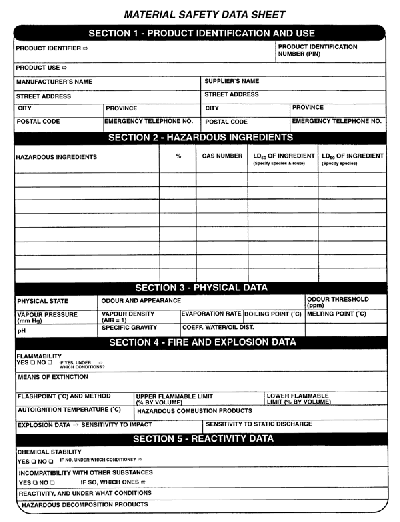
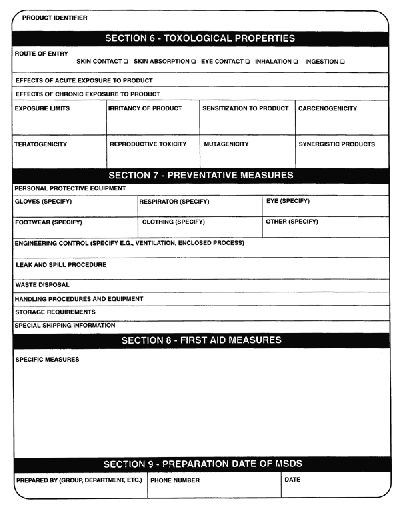
Material Safety Data Sheet - Example
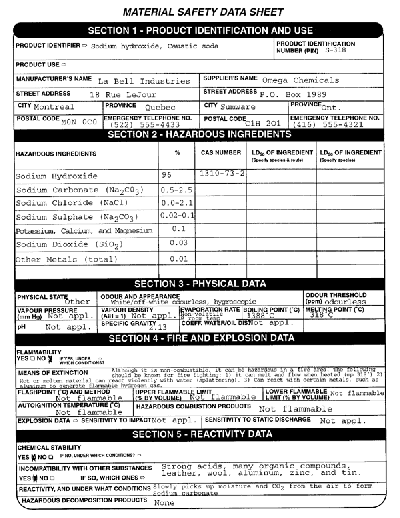
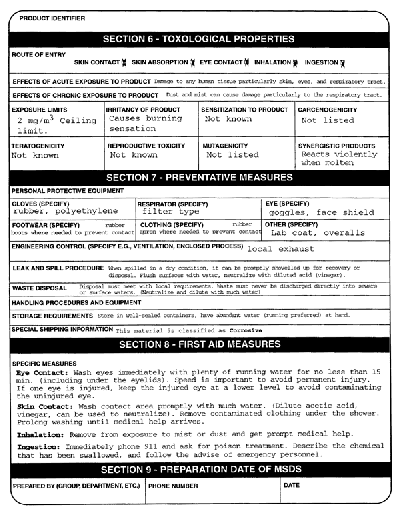
The employer is responsible for worker education and training within WHMIS. Education is based on generic information such as recognizing a complete WHMIS label or understanding an MSDS and is valuable to the worker in any job situation. Training is job-specific. Each worker must receive sufficient training to ensure that correct protective measures are taken when using a controlled product.
Students are included in the definition of a worker in Manitoba's Workplace Safety and Health Act in Section 1 Definitions:
"worker" includes . . .
(c) any person undergoing training or serving an apprenticeship at an educational institution or at any other place . . . .
Therefore, any safety or health regulation using the term "worker" includes "student."
Education and training programs must be reviewed and upgraded annually or more frequently as necessary.


